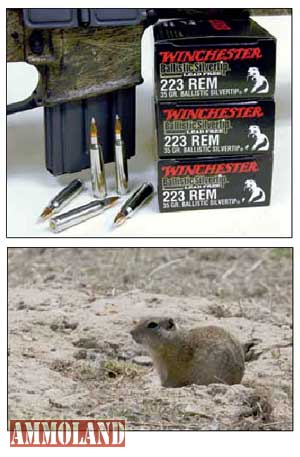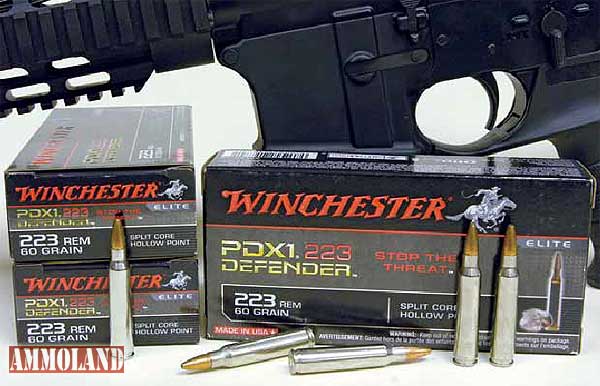By J. Guthrie & Dick Metcalf

East Alton, IL – -(Ammoland.com)- They are go-anywhere, do-anything guns.
They are the “Modern Sporting Rifle.”
We’ve both been using ARs for most of our shooting careers: old Dick since the U.S. Army first put one in his hands way back in 1968; young me since about the time I first learned which end of a gun to point.
And for the past three years, we’ve been hunting companions from coast to coast with these rifles, both with lightweight AR-15s and heavier AR-10 versions, tackling everything from ground squirrels to coyotes and deer and alligators and even elk and bison, using just about every different cartridge the AR design can accommodate.
Not to mention that we both have fully rigged homedefense AR carbines stashed in our bedrooms.
What we’ve learned from all this individual and shared AR experience is that the AR-10 and AR-15 are both up to nearly any task. But the critical component that allows an AR to do an honest day’s work, even more important than all the AR variations on the market and the nearly endless list of AR accessories available, is the ammo you run in it.
No ammunition manufacturer offers a wider range of different loads suitable for use in the AR platforms than Winchester.
There are four basic ways to use an AR-platform rifle or carbine. First: practice, recreation, and competition. Second: varmint and predator shooting. Third: home defense. And finally, hunting medium and big game. As soon as we laid these categories out for this joint article, we started arguing about who would write about what. So we drew straws. I wound up handling the opening, the varmint and predator hunting part, and the medium- and big-game section. Dick drew the practice and fun-shooting category, home-defense section, and the wrap-up. I know he rigged the draw.
Metcalf Practice, Recreation, and Competition
As I’ve tried to tell Guthrie over and over, the only way he’s ever going to get better at this AR shooting thing is to practice. Practice, practice, practice. But practice means shooting lots of rounds.
We all want to save as much money on ammo as possible (so we can afford to buy even more), but it does no good to practice with stuff that won’t shoot straight. What we need is the most affordable top-quality ammo we can find.
For AR-15s, Winchester’s USA label ammunition hits that sweet spot dead-center. There is no better practice ammo for conventional .223-caliber ARs than the USA 55-grain FMJ load. It’s accurate as can be and cheaper than dirt compared to premium-grade stuff.
Also consider the purpose of your practice. If you’re thinking about a prairie dog shoot (or whacking some woodchucks—recreation, indeed), why not practice with the exact same ammo you’ll actually use?
Winchester/USA’s superbly accurate 45-grain JHP load can often be found for about $210 for a 400-round case, which breaks down to nearly the same price as the FMJ stuff.
It’s the same on the AR-10 .308 Winchester side. USA-label 147-grain FMJ can be found for around $115 for a case of 200 rounds or off the shelf for about $12.50 an individual box. Bought any premium-grade .308 ammo lately? It costs a lot more than that. Of course, when your practice eventually leads you to try your hand at formal, Camp Perry-style High-Power Rifle competition, you can always switch up to Winchester’s Supreme .308 Match round loaded with 168-grain Sierra MatchKing BTHP bullets.

Guthrie Varmint / Predator Shooting
Outside of Camp Perry competition or use as a home-defense carbine, the AR’s star shines no brighter for citizen shooters than when it is used for predator hunting and varmint shooting.
Properly built rifles are extremely accurate, and few others can deliver faster follow-up shots.
Winchester offers plenty of good options for predator and varmint shooting. However, I prefer Winchester’s .204 Ruger ammo over the stalwart .223. The 32-grain .204 Ballistic Silvertip leaves a 22-inch barrel at just under 4,000 fps and delivers laserlike trajectories out to 300 or so yards. I usually just range objects around my stand, drawing an imaginary circle of death. Any coyote or bobcat that enters the circle is mine for the taking. On the fringes, it is just a matter of holding a touch high.

Depending on the range and animal size, this energetic and high-fragmentation load will drop most predators in their tracks and is unlikely to severely damage a pelt. At close ranges, the bullet will pretty much disintegrate with maybe just the bullet base leaving a small exit hole. At long range, the bullet still delivers a dramatic upset and usually, none of the fragments have enough energy to exit. This particular .204 load is a perfect balance of energy dump and minimal pelt damage that other classic predator loads have a tough time delivering.
On the other hand, pure varmint shooting for prairie dogs and ground squirrels is all about volume. Most days in a really good dog town, I average 500 to 700 rounds, sometimes more. A heavy-barreled .223 AR paired with a high-quality optic and a stack of 30- round magazines is enough to warm the heart of any dedicated varmint shooter.
If your home state is among the Californicated, Winchester’s new .223 lead-free 35-grain Ballistic Silvertip is an excellent, accurate, and necessary choice. But this kind of Ballistic Silvertip Lead-Free fun can get expensive, so a quality lead-core round that does not cost as much is the preferred ticket where allowed.
A Winchester/USA white box of 45- grain .223 hollowpoints is just about perfect. These lightly constructed poison pills reach velocities of over 3,500 fps, guaranteeing an air-show on hits inside 300 yards. And we’re only talking about $200 to $220 at most discount outlets for a 400-round case, which breaks down to around $10 to $11 per 20 rounds (did Dick say that already?).
Well, you can’t beat that with a stick.
And this ammo is top-quality stuff, capable of holding a minute of angle in most varmint rifles.

Metcalf Home Defense
AR-15s chambered for .223 have increasingly become home defense guns of choice for many Americans, both because of their intimidating aspect and their ease of handling by any responsible member of the family. But ammo of choice for a home defense AR-15 has always been a problem. Winchester has now solved that problem.
In a home crisis, defense firearms are primarily used indoors, and overpenetration has long been an issue with most of the .223 loads conventionally used in AR-15s. There are a lot of good .223 AR loads for law enforcement, but a law enforcement load is not what a homeowner needs. Law enforcement loads need to penetrate because police officers are sometimes required to shoot at armed criminals who are using walls as cover, or inside vehicles. Such circumstances seldom meet self-defense standards in the civilian world.
The solution is Winchester’s new .223 PDX1 Defense load, featuring a unique 60-grain Split Core bullet specifically designed for immediate incapacitation and minimal through penetration. The front portion of the two-part core is soft lead and is not bonded to the jacket, providing instant upset and a massive expanded bullet diameter. The lead rear core is bonded to the jacket to prevent jacket separation, yet quickly slows in the tissue behind the rapidly slowing huge-diameter front end.
The new Winchester .223 PDX1 is the only .223 ammunition specifically engineered for indoor use in home defense. Enough said.
Those wanting to press their favorite AR-10 into similar home defense duty can sleep easier knowing that Winchester has rolled out a new PDX1 Defender load in .308 Win for 2012.
This new cartridge uses a 120-grain bullet with the same Split Core Technology found in the .223 Rem PDX1 Defender loads. Winchester designed this lightweight bullet to perform with massive energy deposit and penetration tailored to fit within the PDX1 Defender line. Having a .308 load that will not over-penetrate at close range is truly a technological marvel. Winchester has delivered yet again.

Guthrie Medium – AND Big – Game Hunting
Conventional hunting cartridges, such as the .308, 7mm-08, .243, and many others, are increasingly being chambered in AR hunting rifles, and Winchester likely has just the right load for them.
After all, if it got right down to choosing just one cartridge for most of North America, the .308 will get most of it done. And just for the record, my professional hunter in South Africa uses a .308 bolt-rifle to cull 2,000- pound eland. Of course, for the larger or tougher game like elk, moose, or black bear (or eland) with a .308 AR-10, choice of a bullet is critical, much more so than in the other hunting categories. Deep penetration and expansion that doubles the original bullet diameter is the accepted formula for big-game success.
When you pair a .308 AR-10 with Winchester’s Nosler-built all-gilding metal 168-grain E-Tip load, only the biggest North American bears are out of reach.
Homogeneous solid bullets such as the E-Tip hit like much heavier lead-core bullets because they retain almost all their weight after impact. I would expect over 25 inches of penetration inside 300 yards with this load, which is plenty to drive into the vitals of the biggest game animal you can hunt with an AR. And even in a lightweight AR-10 the .308 is not a combination that generates the crushing recoil of a “super magnum,” allowing hunters to really place their shots without fear of catching a case of scope-eye. A low-recoiling round with a high-tech bullet can do good work.
Dropping down the weight and toughness scale to simple deer hunting, let’s not forget all those states where whitetails can be hunted with .22-caliber centerfire rifles —no matter how much hot debate this generates in deer camps and hunting forums in other states. A whole lot of us Southern boys took their very first deer with a .223. Never mind that the .223 is the preferred culling cartridge for game managers on most Texas ranches. With a dialed-in AR carbine and Winchester’s fine 64-grain Power Max bonded pointed soft-point, I would confidently hit the woods for a whitetail hunt anywhere a .223 was legal. It’s not just for head or neck shots. With nearly 1,000 ft-lbs of energy at 100 yards, the Power Max bullet design delivers a perfect combination of immediate expansion and deep penetration because it retains so much weight. Deer shot in the heart/lung zone with Winchester’s .223 60-grain Power Max deer load don’t have a choice about riding home in the bed of a pickup truck.

Metcalf Wrapping It Up
Okay. Now that my good ol’ Georgia boy colleague has made his lengthy point (with which I entirely concur; and I’m from Illinois), let’s take stock.
- No question: AR-platform rifles are now the most popular type of rifle in America.
- No question: There is hardly anything you would ever need a rifle to do that an AR-platform rifle can’t.
- No question: AR-platform rifles can be used for more different types of shooting, and have proven themselves for more different types of shooting, than nearly any other rifle design ever devised.
- And no question: Winchester offers a longer list of individual loads appropriate and tailored for AR-platform shooting of all types than any other ammo maker.
See how easy that was?
Be sure to visit Winchester.com and visit the `Live the Legends’ blog to keep up with all things Winchester – including new product information, events, hunting stories, images, videos and more.
About Winchester Ammunition:
With a company heritage dating back to 1866, Winchester Ammunition was there for the taming of the American West, the Allied Forces’ victory in World War II and through the years, millions of fond memories made in the great outdoors. Known as The American Legend, Winchester is a global leader in sporting, law enforcement, military and personal defense ammunition production. Winchester continues to raise the bar with new products like Blind Sider waterfowl and PDX1 Defender personal defense ammunition. For more, visit Winchester.com, or connect with The American Legend on Facebook at Facebook.com/WinchesterAmmunition.

